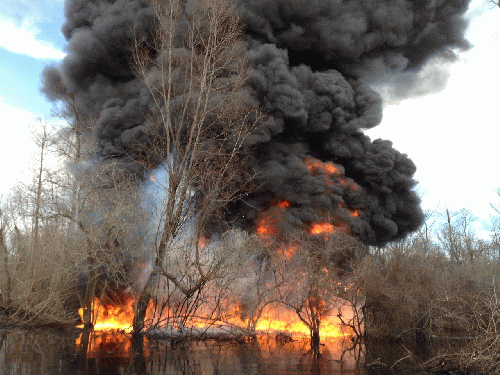It seems that Big Oil and Gas can do whatever it wants to do, and do so with impunity. Ditto for a whole slew of other heavy industries operating in the Deep South. But state and community leaders in the Land of Dixie are getting fed up with land and water pollution problems and are taking legal action against companies that are found negligent of horrid pollution catastrophes.
On Tuesday, Aug. 2, an estimated 4,200 gallons of crude oil was discharged into the mouth of the Mississippi River by Texas Petroleum Investment Co., so reports the U.S. Coast Guard.
According to a press release from the U.S. Coast Guard: "OMI Environmental Solutions and Clean Gulf Associates, oil spill
response organizations, have been contracted by TPIC to conduct clean up
operations. The Coast Guard, Louisiana Department of Environmental
Quality, Louisiana Oil Spill Coordinators Office and Louisiana
Department of Wildlife and Fisheries are also overseeing the response."

Sometimes setting fire to an petroleum drenched swamp is a good thing and the only course of action, as here in remote, wooded swamp tucked inside Bayou Sorrel, La.
(Image by NOAA's Response and Restoration Blog) Details DMCA
"Coast Guard Air Station New Orleans and Southern Seaplane aircrews are conducting aerial assessments of the site and surrounding areas, the press release continues, adding, that "The cause of the incident is under investigation."
The week before, Louisiana's Plaquemines Parish coast was also hit with two oil spills, according to DESMOG, an online magazine that covers environmental and ecological issues, with a main focus on pollution problems.
DESMOG goes on to explain that during late July, it is estimated that 4,200 gallons of crude oil was allegedly spilled into a marsh near Lake Grande Ecaille. This spill was reportedly the result of a company involved with oil and gas extraction named Hilcorp. This spill occurred on July 25. Three days later, 850 gallons were discharged by a Texas Petroleum Management flowline into marshland in the Southwest Pass.
Government officials of Louisiana's Vermilion Parish are seeking legal recourse against oil and gas companies responsible for land loss for damages to this parish's coastal lands. "If successful, the money awarded in these suits will be earmarked for the restoration of Louisiana's coast, which continues to erode at a rate of more than a football field an hour," DESMOG reports.
Big Oil and Gas has targeted the Deep South for exploration and extraction and is doing a hatchet job on wetlands and coastal properties. Another culprit is heavy industry and manufacturing. In Alabama, the West Morgan-East Lawrence Water Authority, along with the residents in Decatur, Alabama, have had enough of this chiseling and land and water rape and have joined in legal battles against manufacturing companies for the high levels of toxicity that Alabama municipalities have experienced in their water supplies.
"The EPA has recognized water contamination issues in Alabama on more than one occasion, and statistics from a 2014 report from the Environment America Research and Policy indicate that Alabama has ranked fourth in the country for states with the highest toxic discharges. Furthermore, manufacturing mills all over the state released 12.3 million pounds of pollutants into the water in 2012 alone (Montgomery Advertiser, 2014). Alabama also ranked second in the nation for release of cancer-causing chemicals, with 119,116 pounds pouring into its rivers and streams (Montgomery Advertiser, 2014)," according to a June 29 online offering in Save The Water.Sometimes swamp pollution is so bad that the best course of action is to set fire to the water. The fiery inferno in the cover photo dates back to the winter of 2013, when a remote, wooded swamp tucked inside Bayou Sorrel, about an hour outside of Baton Rouge, La., was deliberately torched because of a rapidly leaking pipeline.
Kyle Jellison, NOAA Scientific Support Coordinator, wrote in a Feb. 12, 2013 article in NOAA's Response and Restoration Blog: "In early January, a pipeline running underground ruptured, and responders believed it was leaking just a few barrels of crude oil onto land. Then the rains came - and the flooding - and then even more flooding. Right now, up to 4 feet of water is covering the entire affected area (about 1 acre), and cleanup crews are wading through the oil slick in hip waders. This has been quite the challenge."
"Part of my job is to help figure out how we could expedite this cleanup while minimizing damage to the environment. For this case, we agreed that it's time to get out your matches because we're having a fire! It is not for every spill that in situ burning, or the controlled burning of spilled oil in place, comes up. This is the first incident that I have been involved with where burning has been seriously discussed as a spill response option and one of only a few burns conducted in an environment other than a marsh, where the practice is more common for removing oil. (You may remember similar burns on the open ocean during the 2010 Deepwater Horizon/BP oil spill.)," Jellison continues.
"In preparation for the burn, we needed to consider many factors: public safety and health, worker safety and health, effects to vegetation and animal species, proper conditions to sustain combustion, controls for limiting collateral damage, potential quantity of oil removed, and more. The response team determined that rising flood waters would complicate the cleanup operation and increase the probability of the oil escaping containment and spreading throughout the swamp. Controlled burning, on the other hand, could rapidly remove a high percentage of oil while causing minimal local damage to area plant species. (With their roots protected underwater, the plants would be able to grow back after the oiled upper portions were burned off.) As these plans took shape, burn team safety was paramount, and cleanup crews corralled the oil to create thick pools of oil for combustion," Jellison writes.
Pipeline. Pipelines. Pipelines. Are they really worth it? Although Kyle Jellison does an excellent job explaining why fire was set to this swamp, I just have to wonder - why? Why in the world has a pipeline been built in a swamp? According to NOAA's own description of the locale, it is remote, wooded swamp land. Although Jellison writes that at first, "...it was leaking just a few barrels of crude oil onto land...," how does the NOAA actually know this is a fact? I doubt if anyone really goes out into this swamp on a regular basis to check this pipeline, so heaven knows how long and how much this monstrosity actually leaked into the marshy wetlands and onto any boggy land surrounding this very wet place.
It is also very important to look at the state of southern rivers as far as water pollution is concerned. Just like the veins in the bloodstream of a human body, rivers act in about the same capacity for a large landmass. And in this case, the landmass being analyzed is the North American continent. In a Mar 22, 2012, online story published in the St. Louis Post-Dispatch, the paper reported that the Mississippi River is the second most polluted U.S. waterway. The No. 1 polluted U.S. waterway was reported as being the Ohio River, which ironically, flows into Ole Man River directly south of Cairo, Ill."More than 12.7 million pounds of toxic chemicals such as nitrates, arsenic, benzene and mercury were dumped into the Mississippi River in 2010, according to a report released today by the advocacy group Environment Missouri," the St. Louis Post-Dispatch reported a few years ago.
(Note: You can view every article as one long page if you sign up as an Advocate Member, or higher).





